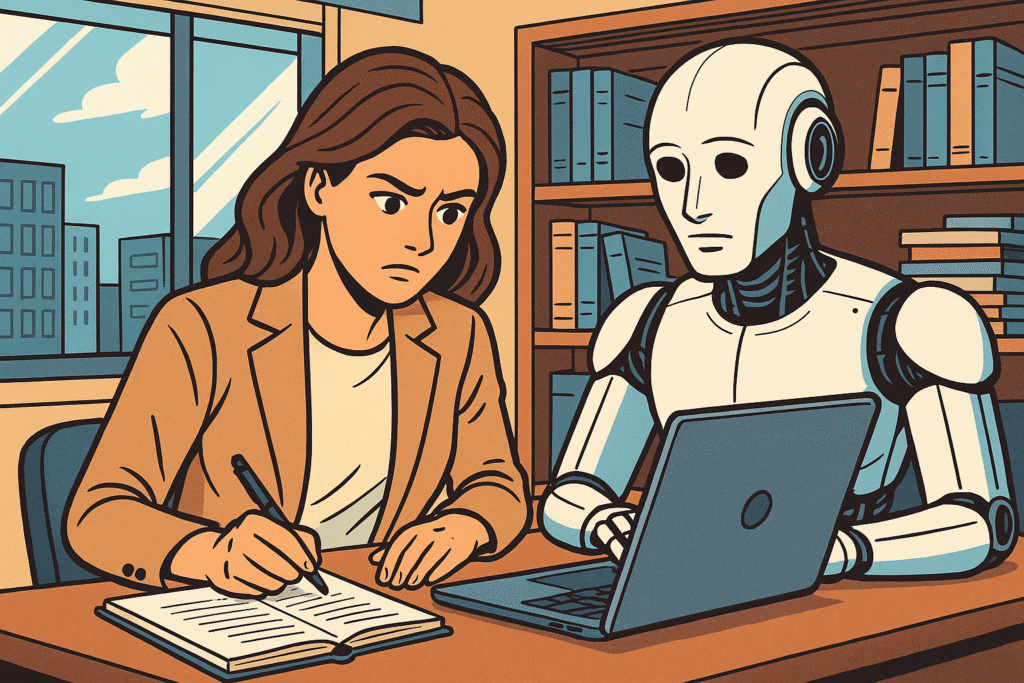One-Line Summary
Ten years from now, artificial intelligence will be deeply embedded in all industries—not as a full replacement for human labor, but as a pervasive assistive infrastructure. While regulations and ethical frameworks mature, demographic aging and productivity stagnation will push nations to depend on AI-driven efficiency and sustainable technologies. Humanity’s challenge will not be to resist AI, but to coexist, adapt, and co-evolve through governance, literacy, and intentional design.
Key Takeaways
- AI’s Role (2035): A universal augmentation layer. Selective automation in administration, content creation, and coding; high-trust domains regulated by risk-based frameworks.
- Job Market Shift: Around 27–28% of jobs in OECD countries face high automation risk. The majority will experience task augmentation rather than replacement.
- Population Change: Global population projected to reach 8.8 billion by 2035 (UN). Aging accelerates, raising dependency ratios and straining welfare systems.
- Technological Landscape: Explosive growth in compute power (×4–5 per year), expansion of renewable energy, electric mobility, and sub-2 nm semiconductors—all intertwined with AI demand.
1. AI’s Real Position in 2035 — Assistance, Selective Replacement, and Everyday Regulation
The IMF and OECD estimate that AI will affect up to 40 % of global employment, yet with distinct regional outcomes depending on regulation and infrastructure. The EU AI Act, entering full force by August 2026, establishes a tiered risk-based regulatory model, making auditability and human oversight standard in healthcare, finance, and government.
In economic terms, AI investment cycles have already softened recessions—IMF notes that AI-driven capital expenditure helped offset U.S. slowdowns in 2025—but policy, ethics, and accountability remain works in progress.
Summary: By 2035, AI will be viewed as a baseline utility—like electricity—where competitiveness depends on compliance, traceability, and responsible design.
2. Labor Market Reconfiguration — From Replacement to Reconstruction
OECD reports that roughly one-quarter of jobs carry high automation potential. Yet the International Labour Organization (ILO) argues that generative AI’s main effect is augmentation, not erasure. Routine clerical, administrative, and low-complexity creative work are most exposed during transition phases, creating friction for younger and less-skilled workers.
Emerging career clusters include:
- AI Governance & Risk Management — auditing model outputs, compliance, and explainability.
- Prompt and Workflow Engineering — retrieval-augmented generation, multi-agent orchestration, synthetic-data curation.
- Semiconductor & Power Infrastructure — packaging, thermal management, and chip-to-photon integration.
- Renewable Energy & EV Ecosystems — maintenance, finance, and grid software.
3. Demographics — Slow Growth, Rapid Aging
According to UN DESA’s World Population Prospects, global population will climb modestly to ~8.8 billion by 2035, then plateau. The dependency ratio will surge as the 60-plus demographic expands; the WHO projects that by 2030, one in six people will be over 60. Labor-age decline across OECD nations will reorient fiscal and social priorities toward healthcare and eldercare automation.
4. Infrastructure & Technology — Energy, Chips, and Mobility
- Compute: Epoch AI data shows frontier-model training compute doubling every ~18 months (4–5× per year growth since 2010).
- Semiconductors: TSMC roadmap targets 2 nm mass production in 2025 and 1.6 nm (A16) by late 2026.
- Energy: IEA forecasts 4.6 TW of new renewable capacity by 2030; electric-vehicle sales to exceed 20 million units annually by 2025, capturing one-quarter of new-car markets.
Together, these advances form the physical substrate of AI expansion—data centers, power grids, and supply chains operating in tight interdependence.

5. The Human–AI Coexistence Code (Practical Guidelines)
A. Individuals — Creators, Knowledge Workers, Developers
- Adopt “Use-AI-First” workflows: Identify three daily tasks to automate. Document accuracy metrics and revise monthly.
- Practice evidence discipline: Verify every numeric or quoted fact via first-source materials (official stats, papers, regulations).
- Data hygiene: Build pre-prompt blacklists for private, copyrighted, or sensitive data.
- Essential Skills: prompt engineering, RAG systems, synthetic data generation, and evaluation metrics.
- Compute awareness: Understand token costs and energy impact; prefer lightweight inference and caching.
B. Organizations — Teams, Studios, Enterprises
- Minimal AI Governance Stack: data catalog + access control + audit log + evaluation metrics; enforce “human-in-the-loop” for high-risk tasks.
- Redesign workflows: channel saved time toward creativity, strategy, and relationship-building.
- Reskilling roadmap: six-month phased program (foundation → domain AI → ops/legal/security).
- Hybrid infrastructure: combine open-source and private on-prem models; segregate access tokens and sensitive RAG pipelines.
- Sustainability lens: monitor energy efficiency, adopt renewable PPAs and low-power inference systems.
C. Society & Policy — Governments, Academia, Industry Alliances
- Mandate AI literacy: integrate source attribution and plagiarism ethics into education and civil-service training.
- Build transition safety nets: job-transfer vouchers and income stabilization schemes for displaced workers.
- Open data as public good: standardize metadata and enable transparent access for research and startups.
Implications
- AI becomes a universal assistive infrastructure; advantage shifts from algorithms to data quality and domain literacy.
- Aging populations demand productivity-centric growth, pairing AI with renewable energy to sustain output.
- Bottlenecks in chips, power, and data centers create both constraints and opportunities for coordinated innovation.
Major Sources
- UN DESA, World Population Prospects 2022 — 2030–2035 trajectory.
- WHO, Ageing and Health (2025) — “1 in 6 over 60 by 2030.”
- OECD, Employment Outlook 2024–2025 — 27 % high-risk automation.
- ILO, Generative AI and Jobs (2025) — augmentation emphasis.
- EU AI Act — 2024 adoption, full enforcement 2026.
- IEA, Renewables 2025 & Global EV Outlook 2025.
- Epoch AI, Compute Trends — exponential compute growth.
- TSMC Roadmap 2025–2026 — N2/A16 nodes.
